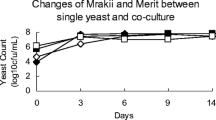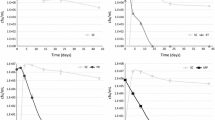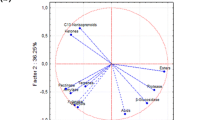Abstract
Surveys conducted worldwide have shown that a significant proportion of grape musts are suboptimal for yeast nutrients, especially assimilable nitrogen. Nitrogen deficiencies are linked to slow and stuck fermentations and sulphidic off-flavour formation. Nitrogen supplementation of grape musts has become common practice; however, almost no information is available on the effects of nitrogen supplementation on wine flavour. In this study, the effect of ammonium supplementation of a synthetic medium over a wide range of nitrogen values on the production of volatile and non-volatile compounds by two high-nitrogen-demand wine fermentation strains of Saccharomyces cerevisiae was determined. To facilitate this investigation, a simplified chemically defined medium that resembles the nutrient composition of grape juice was used. Analysis of variance revealed that ammonium supplementation had significant effects on the concentration of residual sugar, L-malic acid, acetic acid and glycerol but not the ethanol concentration. While choice of yeast strain significantly affected half of the aroma compounds measured, nitrogen concentrations affected 23 compounds, including medium-chain alcohols and fatty acids and their esters. Principal component analysis showed that branched-chain fatty acids and their esters were associated with low nitrogen concentrations, whereas medium-chain fatty esters and acetic acid were associated with high nitrogen concentrations.




Similar content being viewed by others
References
Agenbach WA (1977) A study of must nitrogen content in relation to incomplete fermentations, yeast production and fermentation activity. In Proceedings of the South African Society for Enology and Viticulture, Cape Town, November 1977. South African Society of Enology and Viticulture, Stellenbosch, pp 66–88
Albers E, Larsson C, Liden G, Niklasson C, Gustafsson L (1996) Influence of the nitrogen source on Saccharomyces cerevisiae anaerobic growth and product formation. Appl Environ Microbiol 62:3187–3195
Albers E, Lidén G, Larsson C, Gustafsson L (1998) Anaerobic redox balance and nitrogen metabolism in Saccharomyces cerevisiae. Recent Res Dev Microbiol 2:253–279
Ancin C, Ayestarán B, Corroza M, Garrido J (1996) Clarification by filtration of garnacha must. Utilization of free amino acids during fermentation and bottle-aging of wine. Am J Enol Vitic 47:313–322
Äyräpää T (1967) Formation of higher alcohol from 14C-labelled valine and leucine. J Inst Brew 73:17–30
Äyräpää T (1971) Biosynthetic formation of higher alcohols by yeast. Dependence on the nitrogenous nutrient level of the medium. J Inst Brew 77:266–276
Aznar M, Lopez R, Cacho JF, Ferreira V (2001) Identification and quantification of impact odorants of aged red wines from Rioja. GC-olfactometry, quantitative GC-MS, and odor evaluation of HPLC fractions. J Agric Food Chem 49:2924–2929
Bell SJ, Henschke PA (2005) Implications of nitrogen nutrition for grapes, fermentation and wine. Aust J Grape Wine Res 11:242–295
Bely M, Sablayrolles JM, Barre P (1990) Automatic detection of assimilable nitrogen deficiencies during alcoholic fermentation in enological conditions. J Ferment Bioeng 70:246–252
Bely M, Rinaldi A, Dubourdieu D (2003) Influence of assimilable nitrogen on volatile acidity production by Saccharomyces cerevisiae during high sugar fermentation. J Biosci Bioeng 96:507–512
Bisson LF (1991) Influence of nitrogen on yeast and fermentation of grapes. In: Proceedings of the International Symposium on Nitrogen in Grapes and Wine. American Society for Enology and Viticulture, Davis, pp 78–89
Blateyron L, Sablayrolles JM (2001) Stuck and slow fermentations in enology: statistical study of causes and effectiveness of combined additions of oxygen and diammonium phosphate. J Biosci Bioeng 91:184–189
Butzke C (1998) Survey of yeast assimilable nitrogen status in musts from California, Oregon, and Washington. Am J Enol Vitic 49:220–224
Camarasa C, Grivet J, Dequin S (2003) Investigation by 13C-NMR and tricarboxylic acid (TCA) deletion mutant analysis of pathways for succinate formation in Saccharomyces cerevisiae during anaerobic fermentation. Microbiology 149:2669–2678
Chen ECH (1978) The relative contribution of Ehrlich and biosynthetic pathways to the formation of fusel alcohols. J Am Soc Brew Chem 36:39–43
Eden A, Van Nedervelde L, Drukker M, Benvenisty N, Debourg A (2001) Involvement of branched-chain amino acid aminotranferases in the production of fusel alcohols during fermentation in yeast. Appl Microbiol Biotechnol 55:296–300
Eglinton JM, Heinrich AJ, Pollnitz AP, Langridge P, Henschke PA, de Barros Lopes M (2002) Decreasing acetic acid accumulation by a glycerol overproducing strain of Saccharomyces cerevisiae by deleting the ALD6 aldehyde dehydrogenase gene. Yeast 19:295–301
Francis IL, Newton JL (2005) Determining wine aroma from compositional data. Aust J Grape Wine Res 11:114–126
Fukuda K, Yamamoto N, Kiyokawa Y, Yanagiuchi T, Wakay Y, Kitamoto K, Inoue Y, Kimura A (1998) Balance of activities of alcohol acetyltransferase and esterase in Saccharomyces cerevisiae is important for production of isoamyl acetate. Appl Environ Microbiol 64:4076–4078
Gockowiak H, Henschke PA (1992) Nitrogen composition of grape juice and implications for fermentation: results of a survey made in N-E Victoria. Aust Grapegrow Winemak 340:131, 133–138
Guitart A, Hernández P, Ferreira V, Peña C, Cacho J (1999) Some observations about the correlation between the amino acid content of musts and wines of the chardonnay variety and their fermentation aromas. Am J Enol Vitic 50:253–258
Guth H (1997) Identification of character impact odorants of different white wine varieties. J Agric Food Chem 45:3022–3026
Henschke PA (1997) Stuck fermentation: causes, prevention and cure. In: Proceedings advances in juice clarification and yeast inoculation, Melbourne, Australia. Australian Society of Viticulture and Oenology, Adelaide, pp 30–38, 41
Henschke P, Jiranek V (1993) Yeasts—metabolism of nitrogen compounds. In: Fleet GH (ed) Wine. Microbiology and biotechnology. Harwood Academic, Chur, pp 77–164
Hernández-Orte P, Cacho J, Ferreira V (2002) Relationship between varietal amino acid profile of grapes and wine aromatic composition. Experiments with model solutions and chemometric study. J Agric Food Chem 50:2891–2899
Hernández-Orte P, Ibaz MJ, Cacho J, Ferreira V (2005) Effect of the addition of ammonium and amino acids to must of Airen variety on aromatic composition and sensory properties of the obtained wines. Food Chem 89:163–174
Hernández-Orte P, Bely M, Cacho J, Ferreira V (2006) Impact of ammonium additions on volatile acidity, ethanol, and aromatic compounds production by different Saccharomyces cerevisiae strains during fermentation in controlled synthetic media. Aust J Grape Wine Res 12:150–160
Hohmann S (1997) Shaping up: the response of yeast to osmotic stress. In: Homann S, Mager WH (eds) Yeast stress response. R.G. Landes, Austin, pp 101–145
Howell KS, Cozzolino D, Bartowsky EJ, Fleet GH, Henschke PA (2006) Metabolic profiling as a tool for revealing Saccharomyces interactions during wine fermentation. FEMS Yeast Res 6:91–101
Jiranek V, Langridge P, Henschke PA (1990) Nitrogen requirement of yeast during wine fermentation. In: Wiilliams PJ, Davison DM, Lee TH (eds) Proceedings of the seventh Australian Wine Industry Technical Conference. Australian Industrial Publishers, Adelaide, pp 166–171
Jiranek V, Langridge P, Henschke PA (1991) Yeast nitrogen demand: Selection criterion for wine yeast for fermenting low nitrogen musts. In: Rantz JM (ed) Proceedings of the International Symposium on Nitrogen in Grapes and Wine. American Society for Enology and Viticulture, Davis, pp 266–269
Jiranek V, Langridge P, Henschke PA (1995a) Amino acid and ammonium utilization by Saccharomyces cerevisiae wine yeast from a chemically defined medium. Am J Enol Vitic 46(1):75–83
Jiranek V, Langridge P, Henschke PA (1995b) Regulation of hydrogen sulfide liberation in wine-producing Saccharomyces cerevisiae strains by assimilable nitrogen. Appl Environ Microbiol 61:461–467
Julien A, Roustan J-L, Dulau L, Sablayrolles J-M (2000) Comparison of nitrogen and oxygen demands of enological yeasts: technological consequences. Am J Enol Vitic 46:215–222
Lambrechts MG, Pretorius IS (2000) Yeast and its importance to wine aroma—a review. S Afr Enol Vitic 21:97–129
Manginot C, Roustan JL, Sablayrolles JM (1998) Nitrogen demand of different yeast strains during fermentation: importance of the stationary phase. Enzyme Microb Technol 23:511–517
Mauricio JC, Moreno JJ, Valero EM, Zea L, Medina M, Ortega JM (1993) Ester formation and specific activities of in vitro alcohol acetyltransferase and esterase by Saccharomyces cerevisiae during grape must fermentation. J Agric Food Chem 41:2086–2091
Mendes-Ferreira A, Mendes-Faia A, Leao C (2004) Growth and fermentation patterns of Saccharomyces cerevisiae under different ammonium concentrations and its implications in winemaking industry. J Appl Microbiol 97:540–545
Monteiro FF, Bisson LF (1992) Nitrogen supplementation of grape juice. 2. Effect on amino-acid and urea release following fermentation. Am J Enol Vitic 43:11–17
Nissen T, Schulze U, Nielsen J, Villadsen J (1997) Flux distributions in anaerobic, glucose-limited continuous cultures of Saccharomyces cerevisiae. Microbiology 143:203–218
Oshita K, Kubota M, Uchida M, Ono M (1995) Clarification of the relationship between fusel alcohol formation and amino acid assimilation by brewing yeast using 13C-labeled amino acid. In: Proceedings of the European Brewing Convention. Bruxelles, pp 387–394
Ough CS, Amerine MA (1988) Nitrogen compounds. In: Methods for analysis of musts and wines, 2nd edn. Wiley, New York, pp 172–195
Ough CS, Bell AA (1980) Effects of nitrogen fertilization of grapevines on amino acid metabolism and higher alcohol formation during grape juice fermentation. Am J Enol Vitic 31:25–28
Ough CS, Huang Z, An D, Stevens D (1991) Amino-acid-uptake by 4 commercial yeasts at 2 different temperatures of growth and fermentation—effects on urea excretion and reabsorption. Am J Enol Viticult 42:26–40
Pahlman AK, Granath K, Ansell R, Hohmann S, Adler L (2001) The yeast glycerol 3-phosphatases gpp1p and gpp2p are required for glycerol biosynthesis and differentially involved in the cellular responses to osmotic, anaerobic, and oxidative stress. J Biol Chem 276:3555–3563
Panozzo C, Nawara M, Susky C, Kucharczyka R, Skoneczny M, Bécam AM, Rytac J, Herbert CJ (2002) Aerobic and anaerobic NAD+ metabolism in Saccharomyces cerevisiae. FEBS Lett 517:97–102
Radler F (1993) Yeasts—metabolism of organic acids. In: Fleet GH (ed) Wine microbiology and biotechnology. Harwood Academic, Singapore, pp 165–182
Rapp A, Mandery H (1986) Wine aroma. Experientia 42:873–884
Rapp A, Versini G (1991) Influence of nitrogen compounds in grapes on aroma compounds of wine. In: Proceedings of the International Symposium on Nitrogen in Grapes and Wine. American Society for Enology and Viticulture, Davis, pp 156–164
Remize F, Cambon B, Barnavon L, Dequin S (2003) Glycerol formation during wine fermentation is mainly linked to Gpd1p and is only partially controlled by the HOG pathway. Yeast 20:1243–1253
Sablayrolles JM, Dubois C, Manginot C, Roustan JL, Barre P (1996) Effectiveness of combined ammoniacal nitrogen and oxygen additions for completion of sluggish and stuck fermentations. J Ferment Bioeng 82:377–381
Saerens SMG, Verstappen KJ, Van Laere SDM, Voet ARD, Van Dijck P, Delvaux FR, Thevelein JM (2006) The Saccharomyces cerevisiae EHT1 and EEB1 genes encode novel enzymes with medium-chain fatty acid ethyl ester synthesis and hydrolysis capacity. J Biol Chem 281:4446–4456
Salgueiro SP, Sacorreia I, Novais JM (1988) Ethanol-induced leakage in Saccharomyces-cerevisiae-kinetics and relationship to yeast ethanol tolerance and alcohol fermentation productivity. Appl Environ Microbiol 54:903–909
Salmon JM (1996) Sluggish and stuck fermentations: some actual trends on their physiological basis. Vitic Enol Sci 51:137–140
Siebert TE, Smyth HE, Capone DL, Neuwöhner C, Pardon KH, Skouroumounis GK, Herderich MJ, Sefton MA, Pollnitz AP (2005) Stable isotope dilution analysis of wine fermentation products by HS-SPME-GC-MS. Anal Bioanal Chem 381:937–947
Smyth H, Cozzolino D, Herderich MJ, Sefton MA, Francis IL (2005) Relating volatile composition to wine aroma: identification of key aroma compounds in Australian white wines. In: Proceedings of the Twelfth Australian Wine Industry Technical Conference, Melbourne. Australian Wine Industry Technical Conference, Adelaide, pp 31–33
Swiegers JH, Bartowsky EJ, Henschke PA, Pretorius IS (2005) Yeast and bacterial modulation of wine aroma and flavour. Aust J Grape Wine Res 11:139–173
Torrea D, Henschke PA (2004) Ammonium supplementation of grape juice—effect on the aroma profile of a Chardonnay wine. Tech Rev 150:59–63
Torrea D, Fraile P, Garde T, Ancín C (2003) Production of volatile compounds in the fermentation of chardonnay musts inoculated with two strains of Saccharomyces cerevisiae with different nitrogen demands. Food Control 14:565–571
Torrea D, Siebert TE, Liebich BK, Ancin C, Francis IL, Henschke PA (2005) Effect of ammonium supplementation of a Chardonnay must on wine aroma. In: Blair RJ, Williams PJ, Pretorius IS (eds) Proceedings of the 12th Australian wine industry technical conference, Melbourne, Australia, 24–29 July 2004. Australian Wine Industry Technical Conference: Adelaide, p 293
Valero E, Millan C, Ortega JM, Mauricio JC (2003) Concentration of amino acids in wine after the end of fermentation by Saccharomyces cerevisiae strains. J Sci Food Agric 83:830–835
Varela C, Pizarro F, Agosin E (2004) Biomass content governs fermentation rate in nitrogen deficient wine musts. Appl Environ Microbiol 70:3392–3400
Vianna E, Ebeler S (2001) Monitoring ester formation in grape juice fermentation using solid phase microextraction coupled with gas chromatography–mass spectrometry. J Agric Food Chem 49:589–595
Vos PJA, Crous E, Swart L (1980) Fermentation and the optimal nitrogen balance of musts. Wynboer 582:58–63
Yoshimoto H, Fukushige T, Yonezawa T, Sone H (2002) Genetic and physiological analysis of branched-chain alcohols and isoamyl acetate production in Saccharomyces cerevisiae. Appl Microbiol Biotechnol 9:501–508
Acknowledgements
We thank Dr. Paul Chambers for reviewing this manuscript. This work was financially supported by grant from Galicia Government (Xunta de Galicia, Spain) and by Australia’s grapegrowers and winemakers through their investment body, the Grape and Wine Research and Development Corporation, with matching funds from the Australian Government.
Author information
Authors and Affiliations
Corresponding author
Rights and permissions
About this article
Cite this article
Vilanova, M., Ugliano, M., Varela, C. et al. Assimilable nitrogen utilisation and production of volatile and non-volatile compounds in chemically defined medium by Saccharomyces cerevisiae wine yeasts. Appl Microbiol Biotechnol 77, 145–157 (2007). https://doi.org/10.1007/s00253-007-1145-z
Received:
Revised:
Accepted:
Published:
Issue Date:
DOI: https://doi.org/10.1007/s00253-007-1145-z




